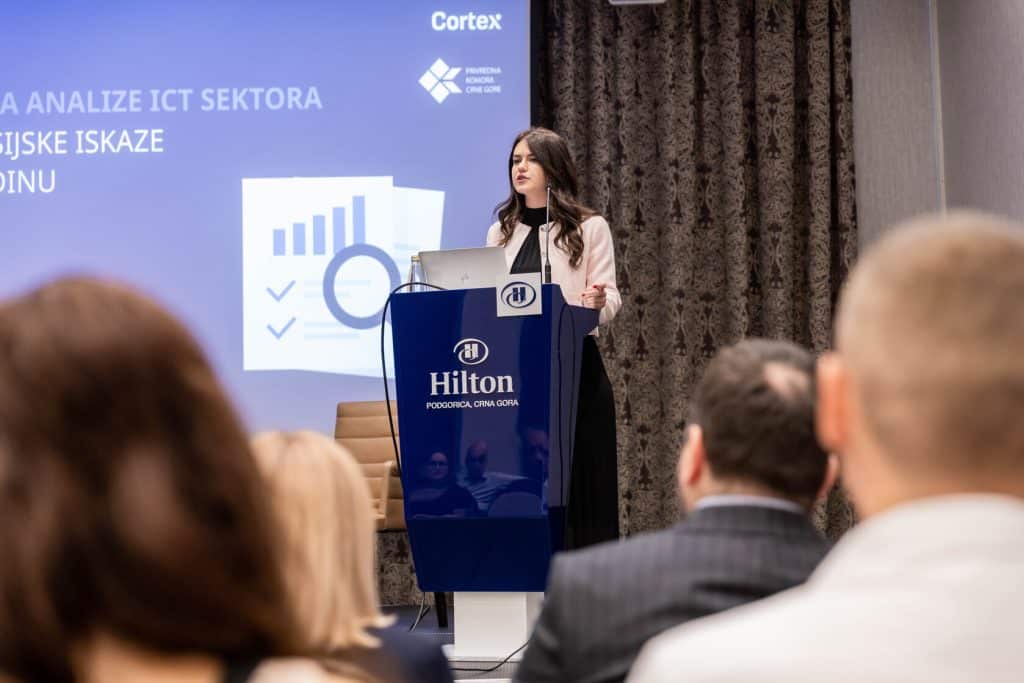The Chamber of Commerce of Montenegro and the ICT Cortex cluster organized a presentation of the Analysis of the Information and Communication Technology Sector through financial statements for the year 2023 on July 5th.
The focus of the event was on the ICT market over the past year, with particular emphasis on key trends and assumptions for positioning the IT industry as one of the key growth sectors of the economy.

The President of the Chamber of Commerce, Dr. Nina Drakić, stated that the ICT sector achieves great results year after year.
“Our ICT sector is one of the most dynamic and fastest-growing branches of the economy and, according to all available indicators, shows continuous growth and achieves outstanding results. Data from financial statements confirm this trend and point to the enormous potential that the ICT sector has for the future development of our economy,” said Drakić.
The Chamber is dedicated to supporting all initiatives that contribute to the development of ICT and the digital transformation of the Chamber, public institutions, and the economy, recognizing that this is key to sustainable growth and development.
“Our companies can develop advanced technological solutions that are competitive in the global market, thereby increasing exports and reducing the need for importing similar solutions. This not only strengthens our economy but also enhances Montenegro’s image as a technologically advanced country. Digitalization is an indispensable factor in modern business, and we are determined to return Montenegro to the position of a leader in this process in the region,” concluded the President.

“There is a lot of room for the state to stimulate the development of the ICT sector. This is a highly potent branch that can transition into a vertical sector of the economy,” assessed the Secretary of the Association Board of the Chamber of Commerce, Nada Rakočević.
One of the challenges in analyzing statistical data is that a significant number of IT companies are registered under incorrect industry codes and, therefore, are not part of the official ICT statistics, highlighted Milena Aković, Marketing Director of the ICT Cortex cluster.
“The ICT sector accounts for 11 percent of GDP and employs 2.75 percent of the workforce. It is the fastest-growing sector in the last 10 years, accounting for 25 percent of total exports and providing the quickest return on investment,” said Aković.

To create an insight into potential results beyond the official statistics, certain companies were mapped and the analysis was supplemented. This ultimately indicates that the total revenue in the ICT sector exceeded 750 million euros in the previous year.
As part of the event, a panel discussion was held on the topic “ICT – How to Transition from a Horizontal to a Vertical Sector.”
“ICT is making impressive progress. It is sufficient to say that it contributes 25 percent to exports, while a decade ago that number was ten times smaller. Now is the right time to consider our next steps in its development,” said the moderator, Valentina Radulović, Director of the Science and Technology Park.

Ratko Nikolić, Executive Director of BI Consulting, stated that the ICT sector has quadrupled in terms of the number of companies and revenues compared to 2019.
“If we consider the entire ICT sector as a whole, comprising IT services, telecommunications, and IT equipment trade, there have been changes among the individual segments in the recent period. During the pandemic year of 2020, the IT services sector surpassed the IT equipment trade in terms of revenue and was the only one of these three segments that did not experience a decline due to the crisis. From this, we conclude that this is an industry capable of ‘smoothing out’ economic fluctuations during times of crisis,” said Nikolić.

The President of the ICT Association of the Chamber of Commerce, Branimir Bukilić, stated that the IT sector could grow further if it created and exported its own products instead of “raw knowledge.”
“The idea is to convert the existing knowledge in our IT companies, which predominantly work on exporting raw knowledge for designers and innovators from other countries, into innovative projects and product creation. Let’s find a way to motivate them to develop and sell their own products,” Bukilić emphasized.

During the panel, the importance of the S3 strategy was highlighted, emphasizing the need to create infrastructure for innovations and to initiate a new cycle of entrepreneurial discovery.
